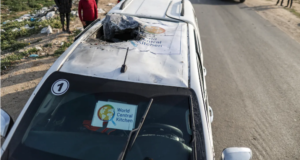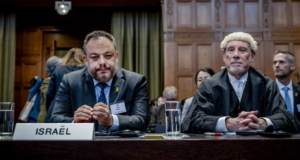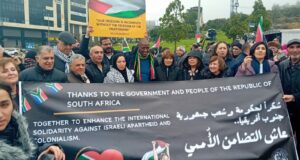22 May 2011 | International Solidarity Movement
The right to return is a core goal of the Palestinian liberation struggle. Since 1947-1948, when over 750,000 Palestinians were forcibly expelled from their homes – and more than 700,000 were ethnically cleansed from their country altogether – they and their descendants have organized to demand the rectification of this historic injustice. The refugees of the Six-Day War in 1967 (after which Israeli forces drove 300,000 Palestinians out of the occupied Gaza Strip and West Bank ), the 1967-1994 Israeli administration of the occupied territories (during which Israel stripped 140,000 Palestinians of their residency rights), and the ongoing colonization of Palestine and displacement of its indigenous inhabitants, have added their voices to the growing global movement for return.
In recent years, the right to return has also emerged as a key demand of international solidarity activists supporting Palestinian aspirations for freedom. On July 9, 2005, for example, the Palestinian Civil Society Call for Boycott, Divestment, and Sanctions (BDS) – the founding document of a Palestinian-led global movement for justice in Palestine – stated that “non-violent punitive measures should be maintained until Israel meets its obligation to recognize the Palestinian people’s inalienable right to self-determination and fully complies with the precepts of international law by … respecting, protecting and promoting the rights of Palestinian refugees to return to their homes and properties.”
Today the seven million Palestinian refugees are the world’s largest group of refugees, comprising one-third of the total refugee population. Their right to return to their homes, and to receive compensation for the damages inflicted on them, are enshrined in international law. Resolution 194, which the United Nations General Assembly adopted on 11 December 1948 and Israel agreed to implement as a condition of its subsequent admission to the United Nations,
resolves that the refugees wishing to return to their homes and live at peace with their neighbours should be permitted to do so at the earliest practicable date, and that compensation should be paid for the property of those choosing not to return and for loss of or damage to property which, under principles of international law or in equity, should be made good by the Governments or authorities responsible.
Additionally, the Universal Declaration of Human Rights, adopted by the General Assembly on December 10, 1948, states that “everyone has the right to leave any country, including his own, and to return to his country.” And Resolution 3236, which the General Assembly adopted on November 22, 1974, “reaffirms … the inalienable right of the Palestinians to return to the homes and property from which they have been displaced and uprooted, and calls for their return.”
Despite its clear obligations under international law, Israel continues to resist demands by Palestinian refugees that they are allowed to return to their homes. Most recently, on Sunday, May 15, the 63rd commemoration of the Nakba, or “catastrophe,” of the 1947-1948 ethnic cleansing of Palestine, Israeli troops responded to demonstrations by unarmed refugees marching towards their homes with lethal force.
Israeli forces killed at least 15 demonstrators on three borders (with occupied Gaza, Lebanon, and between Syria and the occupied Golan Heights), wounded hundreds more with live gunfire, artillery shells, and tear gas, and unleashed a wave of arrests and repression in the occupied West Bank. This massive violence could only have been planned as a show of brute force, intended, along with Benjamin Netanyahu’s repeated assertions that “it’s not going to happen,” to dissuade Palestinian refugees from asserting their historic rights and the global consensus for the right of return.
Yet the most enduring story from May 15 may be that of Hassan Hijazi. A 28-year old Palestinian refugee living in Syria, he braved the gunfire that killed four others along the border with the occupied Golan Heights, then hitchhiked, and finally took a bus, to his family’s home in Jaffa. Before turning himself in to Tel Aviv police, he told Israeli reporters, “I wasn’t afraid and I’m not afraid. On the bus to Jaffa, I sat next to Israeli soldiers. I realized that they were more afraid than I was.”
Millions more are resolved to follow Hijazi’s path. On Sunday, June 5, the 44th commemoration of the Naksa, or setback, Israel’s 1967 expulsion of 300,000 Palestinians following the Six-Day War, Palestinian refugees will return en masse to the borders. Announcing the mobilization on May 18, the Third Intifada Youth Coalition said, “The last few days proved that the liberation of Palestine is possible and very achievable even with an unarmed massive march if the nation decides it is ready to pay all at once for the liberation of Palestine.”
The Preparatory Commission for the Right to Return, a nonpartisan coordinating body, has requested that supporters of the Palestinian liberation struggle also take action on June 5, by staging rallies, marches, and protests throughout the world demanding Palestinian refugees’ right to return. Appropriate venues could include Israeli embassies, consulates, and missions, BDS campaign targets, and foreign governments and international organizations that enable Israeli crimes.
”The May 15 marches were not an isolated incident, but were rather a declaration of the foundation of a new stage of struggle in the history of the Palestinian cause, entitled: ‘The refugees’ right to return to their homes,’” a statement by the Commission says.
For the first time ever, the Palestinians have switched from commemorating their displacement with statements, festivals, and speeches, to actual attempts to return to their homes.
The scene of refugees marching from all directions towards their homeland of Palestine sent a powerful message to the entire world that the refugees are determined to return to their homes however long it may take; and that 63 years were not enough to kill their dream of return; and that the new generations born in forced exile who have never seen their homeland are no less attached than their grandparents and fathers who witnessed the Nakba.
What happened on May 15 was only a microcosm of the larger march soon to come, a march that will be made by Palestinian refugees and those who support them. They will pass the barbed wire and return to their occupied villages and cities.
The crowds will head out from everywhere there are Palestinian refugees toward the West Bank, the Gaza Strip, and occupied Palestine’s borders with Jordan, Syria, and Lebanon, in peaceful marches raising the Palestinian flag and the names of their villages and towns, the keys to their homes, and certification papers.
The Arab Spring’s “winds of change” are blowing through the refugee camps, no less than the Arab capitals, toward Palestine. And they show no signs of stopping.
 International Solidarity Movement Nonviolence. Justice. Freedom.
International Solidarity Movement Nonviolence. Justice. Freedom.



